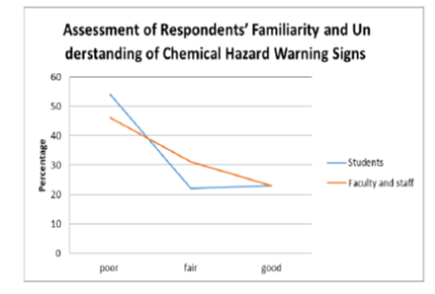


Indian Journal of Science and Technology
Year: 2021, Volume: 14, Issue: 45, Pages: 3295-3303
Original Article
Melanie Santos Manuel1*, Bernadette Colangan Aggabao2, Cherry Ann Doctor Bona3
1Prk.1 Bulanao, Tabuk City, Kalinga
2Calanan, Tabuk City, Kalinga
3Magsaysay, Tabuk City, Kalinga
*Corresponding Author
Email: [email protected]
Received Date:12 June 2021, Accepted Date:16 November 2021, Published Date:22 December 2021
Objectives: This study investigated the perception of the students, faculty members, and staff of Kalinga State University about chemical safety in the laboratories, including their familiarization with chemical hazards and warning symbols. Methods: A sample size of 124 respondents, primarily females, were 10 faculty members, a University Official, and one hundred thirteen (113) students. A questionnaire was used to collect data which were analyzed using descriptive statistics. In the questionnaire, at least 32 questions were used with five sections: demographic data, different GHS pictograms, and approach to safety in chemical laboratories, the practice of students within the laboratory, and knowledge and familiarity with emergency equipment and procedures to assess their knowledge, attitudes, and practices on their familiarity and understanding of chemical hazards in the laboratories. In addition, a semi-structured interview was done after answering the questionnaires to gain deeper insight from the respondents on their knowledge, attitudes, and practices about safety while working in the laboratory. Findings: Descriptive statistics conveyed that students, faculty, and staff demonstrated poorly on familiarity and understanding of chemical hazards and warning symbols. Students displayed a poor attitude towards chemical safety but demonstrated fair responses to chemical safety practices. Though faculty and staff displayed fair attitudes towards chemical safety and practices, educational reinforcement and conduct of safety ethics and risk management in the chemical laboratory are recommended for the subjects in charge. The study concluded and recommended that an in-depth education and training need to be implemented for all university students on testing facilities, chemical safety devices, and other standard protocols encountered in the laboratory parallel to the suggestions and recommendations of fellow researchers in the field(1). (Ejilemele & Ojule, 2005)
Keywords: Chemical safety; chemical hazards; emergency equipment; safety devices; standard protocols
© 2021 Manuel et al. This is an open-access article distributed under the terms of the Creative Commons Attribution License, which permits unrestricted use, distribution, and reproduction in any medium, provided the original author and source are credited.
Published By Indian Society for Education and Environment (iSee)
Subscribe now for latest articles and news.